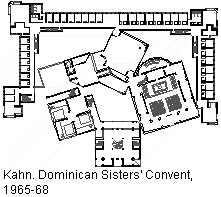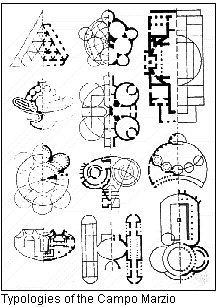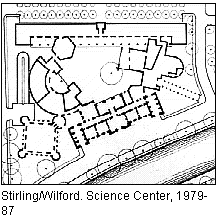Redrawing the Campo Marzio
1997.08.08
After rereading some of Tafuri's text on the Campo Marzio, for some reason it occurred to me that my redrawing of the Campo Marzio is an attempt to "walk in Piranesi's footsteps," meaning, I am trying to learn how Piranesi's imagination operated by doing the same thing he did--literally (re)drawing the plan. I am trying to get as close to Piranesi's own drawing/designing procedure as possible.
I then thought of what Collingwood said about not being able to truly learn from history because we are not able to actually experience history. In this sense, I am trying to re-experience a specific historic occurrence, albeit over 200 years later and with a different drawing technology. Besides the use of CAD, which is actually related to engraving in that it is a type of "drawing" that is readily reproducible, the major difference between what Piranesi did and what I am doing is that Piranesi was designing the plan(s) as he was drawing them, he was producing with his imagination and with his graphic dexterity. Whereas I am only measuring his work and then digitally inputting the data. I am learning through osmosis, however.
"Redrawing History: G.B.Piranesi's Campo Marzio in the Present"
...the opportunity to delve into the virtual realm and how reality and the virtual very much cross paths in the Campo Marzio.
in memory of Aldo Rossi
1998.01.18
I now see that Rossi's death in September '97 fits precisely into the Redrawing the Ichnographia of Piranesi's Il Campo Marzio dedication. Since September I have discovered the connection between Rossi's Modena Cemetery and Piranesi' Bustum Hadriani. The profusion of coincidences here is almost unbelievable: cemetery, bustum, axis of death, death in September, link to Piranesi...
Encyclopedia Ichnographica
1998.07.04
Piranesi's Ichnographia Campus Martius, the large plan within the archeological text Il Campo Marzio dell'antica Roma, has inspired numerous architects since its first printing in 1757, yet the Encyclopedia Ichnographica is the first full-scale analysis of the plan's composition, meaning, and message. While representing a reenacted plan of ancient Rome's Field of Mars, Piranesi ingeniously delineates two narratives -- that of pagan Rome and that of Christian Rome -- and at the same time offers an unprecedented lesson in urban design.
Presented here as a work-in-progress, the Encyclopedia Ichnographica will address every detail of Piranesi's plan through an ongoing delivery of descriptive and analytical texts along with computer generated illustrations of the plan redrawn.
Fathoming the Unfathomable
Stephen Lauf
1998.07.08
fathom b : intellectual grasp, penetration, or profundity : COMPREHENSION
unfathomable : not capable of being fathomed a : INCOMPREHENSIBLE, INSCRUTIBLE [all that is cryptic and unfathomable in humanity --J.L.Lowes] b : IMMEASURABLE, IMPENETRABLE
intrigue 3 : the plot of a literary or dramatic work esp. marked by an intricacy of design or action or a complex interrelation of events
Giovanni Battista Piranesi's Ichnographia Campus Martius is unquestionably a plan full of intrigue. The depth of its detail is equally matched by the depth of its meaning. To understand this plan requires total immersion, even though every aspect of the plan is already completely open to view. Therein lies the Ichnographia's greatest irony -- all the pieces are visibly in place while the overall effect remains a puzzle.
The Encyclopedia Ichnographica is the result, so far, of over a decade's worth of re-drawing and re-search, with the joint goal of both efforts being to lift the Ichnographia's shroud of puzzlement, as well as to finally place Piranesi's plan among architecture's paramount designs. Working with the Ichnographia is still rarely easy, however; the Latin labels throughout the plan do not always translate well, Piranesi's archeological inaccuracies are enduring hurdles, and the ongoing reading of both ancient and modern texts, along with reading and re-drawing the hundreds of plans within the large plan, is continually intense. Nevertheless, the Ichnographia rewards splendidly because, after the removal of many layers of incomprehensibility, Piranesi's large plan delivers numerous double narratives where inversion, if not satire, is the dominant theme. In more concise terms, the Ichnographia comes to represent Piranesi's delineation of ancient Rome's story from beginning to end.
After so many years of being intimately involved with the Ichnographia Campus Martius, it is slightly disconcerting to not know exactly when I first saw the large plan. If memory serves me correctly, my initial knowledge of Piranesi's Campo Marzio plan came with the anecdote of how a copy of the plan hung over Louis I. Kahn's office desk. Even though I now know that Vincent Scully relates this information within his book, Louis I. Kahn, I believe the account of the Ichnographiam hanging over Kahn's desk is something I originally heard in architecture school rather than read, and, since many of the mid-1970s faculty members at Temple University's Department of Architecture were either students of Kahn or had worked in Kahn's office, my assumption is reasonably sound.
Almost as a matter of course, the early years of my architectural education produced a strong personal interest in Kahn's geometric planning, specifically Kahn's unique ability of turning rigorous combinations of simple shapes into elegant plan compositions. Piecing things together, it then seemed obvious that Piranesi's plan of the Campo Marzio was a source of inspiration for Kahn's planning principles. Therefore, if I was to learn how to design like Kahn, I too needed Piranesi's plan for inspiration.
 
The Ichnographia remained elusive, however. My search through books and journals yielded reproductions of only portions of the plan, or reduced reproductions of the entire plan were near the point of illegibility. Over several years, I was still not able to compile a readable image of the Ichnographia, nevertheless, other factors began to broadened my comprehension of the plan. A group of diagrams labeled Typologies of the Campo Marzio, which appeared in the Summer 1978 edition of Oppositions 13, indicated that an investigation of Piranesi's plans had already occurred, yet the article [George Teyssot (Christian Hubert, trans.), "Emil Kaufmann and the Architecture of Reason: Klassizismus and 'Revolutionary Architecture'" in Oppositions 13 (Cambridge, MA: The MIT Press, Summer, 1978).] that included the 'typologies' offered no explanation of the analysis behind the diagrams. Even so, the diagrams present a clear message regarding a congruous geometry underlying the Ichnographia's individual plans. This finding registered a shift in my overall interest of the large plan so that, rather than wanting to learn about what inspired Louis Kahn's method of designing buildings and drawing plans, I became much more inquisitive as to what inspired Piranesi's distinctive ichnographic method.
The other factor that shifted my interest in Piranesi's Campo Marzio was a Stirling/Wilford building from 1979, which manifestly combined the ideas of typology and collage into a single coherent architectural design, the Wissenschaftszentrum (Science Center), Berlin. This Stirling/Wilford design is certainly a "spin-off" of Kahn's Convent for the Dominican Sisters, yet the Berlin building also clearly introduces a new motif within late 20th century architecture, namely the notion that formal abstraction can also include tectonic shapes that possess distinct architectural and typological associations. Of course, this methodology does not come without irony because the associations rendered through the Science Center design in no way relate to the building's functional program, yet the use of recognizable and comprehensible forms within a building's design still adds a potent element whereby modern architecture is able to deliver a readable message. I saw Stirling/Wilford's new approach as a further extension of the inspiration Kahn initially derived from Piranesi, and my supposition was reinforced by Charles Jencks who, as guest-editor of Architectural Design's 'Post-Modern Classicism,' [Charles Jencks, guest editor, "Post-Modern Classicism -- The New Synthesis," Architectural Design, vol. 50, no. 5/6, 1980, p. 75.] without explanation placed Piranesi's aerial perspective of the Campo Marzio next to a top view photograph of a model of the Science Center.
 
My formal architectural education thus ended in May 1981 with my designing an Institute of Contemporary Art where I explored typology and collage, and, judging from the design's schematic sketches, Piranesi influenced me more than I probably cared to admit at the time. Furthermore, as fate would have it, within weeks of my graduation I found a poster of the Ichnographia in the AIA Philadelphia Bookstore. I immediately purchased the poster, and promptly hung it over my drafting table at home.
| |
Encyclopedia Ichnographica
1999.11.07 20:43
As it stands now, my ongoing investigation and redrawing of the Ichnographia has led to the 'discovery' of a whole new aspect of Piranesi's work that so far no one else has found, namely that the large plan of the Campo Marzio is a readable narrative of Ancient Rome's political and architectural history--but in order to grasp this delineated 'text' one must 'read' in unison the individual plans, the plans in relationship to each other, the plans in relation to where the actual buildings really were, and (this is perhaps the most important) the Latin labels Piranesi gives to each plan.
reenactment
1999.11.09 10:28
When I first began to redraw Piranesi's Campo Marzio using CAD, I was doing so to get as close to Piranesi as possible; essentially, I was reenacting his act of drawing as best I could. For me, this exercise, this reenactment, has provided enormous insight albeit it took several years of continual work for this vision to develop. I am certainly not Piranesi, nor do I contend to possess his superior creative talent and imagination, but I deliberately attempted to do some of the same things he has done, and in so doing I honestly believe I removed several degrees of separation. Perhaps reenactments then are always a play with degrees of separation, sometimes seeing how close one can get to the 'original' and/or sometimes seeing how far one can "stretch the truth," to name the extreme cases.
Re: TX2/Plato's Spelunking
2001.12.04 12:26
Last week I started reading Yates' The Art of Memory. The first chapter describes how the ancient Romans "taught" memory (now known as mnemonics). Briefly, there was/is this whole operation of setting up something like a (house) "plan" in your mind and then placing what you want to remember in designated "rooms". After somewhat understanding the principle, it dawned on me that the Ichnographia Campus Martius is very much such a "memory plan". I freely admit that my present retention of data relative to ancient Rome is greatly aided (if not in fact generated) by my "hands-on" knowledge of Piranesi's plan. It seems that I was actually practicing (albeit unwittingly) a type of mnemonics as I was CAD redrawing the Ichnographia.
This leads to wondering if there are other "memory places" being created out there.
not Tampa, Florida anymore
2002.01.10 00:40
I'm glad you found some useful information, and I hope it helps toward some resolution to how you see that reenactment (potentially) relates to predestination and psychology. I haven't been coming to reenactment from that angle, so I don't even understand exactly what you're seeing. (But that doesn't at all mean that I think what you're seeing is somehow wrong or misinterpreting.)
I'll try to briefly outline (reenact) how I came to see a strong relationship between reenactment and (some but certainly not all aspects of) design.
I began redrawing Piranesi's Campo Marzio plan with CAD in 1987. I've been fascinated with this plan since the late 1970's, and I saw the opportunity to utilize the automated drawing/drafting capabilities of CAD in (re)drawing all the complicated individual plans of the Campo Marzio, which comprise many repetitive units, and manipulating repetitive units is precisely one of the things CAD is very good at facilitating.
In the early 1990s I begin an intensive redrawing of the plan, and at the same time I became reacquainted with Susan Dixon, a friend from my college days who went on to get a Ph.D. in Art History, and her dissertation was on Piranesi's archaeological publications, of which the Il Campo Marzio is one. Together (via phone conversations) Susan and I begin speculating as to what the meaning of the Campo Marzio plan might be. Many theories were speculatively put forth, but reenactment was never one of them.
The second week of August 1997 I split my energies between doing research on the Campo Marzio and research on the philosophy of history as it might relate to my theory of chronosomatics. In Encyclopedia Britannica (edition 1969) under "Philosophy of History" there is a passage explaining Vico which, while reading it, made me think of Piranesi's Campo Marzio. There is also a list of 20th century philosophers of history and the titles of the works. Collingwood's The Idea of History is among these. I go to Barnes and Nobles that same day and buy Vico's New Science and Collingwood's The Idea of History. I read the passages in The Idea of History that deal with reenactment. It dawns on me that I've been doing a kind of reenactment by redrawing Piranesi's plan.
Thursday, September 4, 1997 (coincidentally the day architect Aldo Rossi died) I find Plattus's "Passages to the City: The Interpretive Function of the Roman Triumph" in Ritual (1983). I finish reading the essay Friday night. Saturday morning I watch Diana's funeral, and it quickly hits me that I am watching exactly what I just spent the last two nights reading about. Since Piranesi himself delineated the path of the Triumphal Way through his plan of the Campo Marzio, I begin to wonder whether Piranesi too was playing some kind of reenactment game in his redrawing of the large urban plan.
It is after this point that much of the prior ten year's work begins tightly piecing together, and the notion of reenactment also aids in better understanding what information I collected further in research.
For me, reenactment was a learning tool, albeit for the most part a tool I didn't even know I was using. For Piranesi, however, (and this is what I've come to understand) reenactment was a design tool, specifically an urban design tool, whereby he generated an entirely new rendition of Rome. A Rome, moreover, that is essentially a conglomeration of many specifically themed environments, i.e., themed environments that relate exactly the history of the very places where Piranesi positioned his new designs. This is why I say Piranesi's Campo Marzio is not a reconstruction, rather a reenactment. By all indications, Piranesi was very conscious of the play of degrees of separation that reenactments involve.
Piranesi also (re)designed the city of Rome as a double (history) theater, namely the double theater of Rome's Pagan and Christian existence.
Finding a Lost Piranesi
2002.01.14
The title itself generated the project, and the notion of my having found a lost Piranesi (i.e., the first state of the Ichnographia)...
"Finding a Lost Piranesi" ...with a quite fortuitous connection to the notion that reenactment has a possible relationship with predestination -- "Was I predestined to find the lost Ichnographia because I have been reenacting (redrawing) the Ichnographia?"
...a straight forward acccount of the actual finding [of the circus changes] and its documentation
|